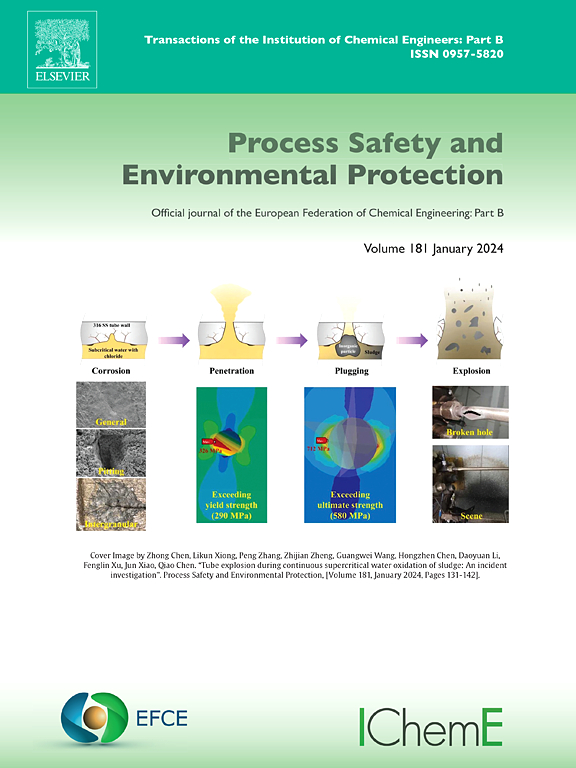用于油水乳液分离的亲水改性ZIF-8嵌入二维蛭石膜:超润湿性、性能及机理
IF 6.9
2区 环境科学与生态学
Q1 ENGINEERING, CHEMICAL
引用次数: 0
摘要
随着全球水资源的日益短缺和人们对环境的日益关注,全球对含油废水处理的需求不断增加。膜处理技术作为一种极具发展前景的技术,在含油废水的处理中得到了广泛的应用。目前,二维材料膜以其独特的结构和优异的性能得到了广泛的应用。本研究利用亲水单宁酸修饰的ZIF-8 (T-ZIF-8)作为插层剂,制备了一种二维蛭石(VMT)膜,以提高VMT的层间距和表面粗糙度。优化后的醋酸纤维素(CA)膜(T-ZIF-8@VMT/CA)具有超亲水性和水下超疏油性(UWOCA>153°)。该膜的水通量为2.2 × 103 L·m−2 h−1,比VMT/CA膜提高了20倍。T-ZIF-8@VMT/CA膜对各种水包油乳液的分离效率高达99.4 %,长期运行3 h后,分离效率达到98.4 %。分子动力学模拟结果表明,T-ZIF-8改性能有效改善乳化油的界面破乳和重力驱动分离。T-ZIF-8@VMT/CA膜具有耐酸碱、可重复使用和抗菌性能。综上所述,该方法可以同时提高水通量和分离效果,在实际废水处理中具有广阔的应用前景。本文章由计算机程序翻译,如有差异,请以英文原文为准。
Hydrophilic modified ZIF-8 embedded two-dimensional vermiculite membrane for oil-water emulsion separation: Super-wettability, performance and mechanisms
With the increasing global water scarcity and people's increasing concern for the environment, the global demand for oily wastewater treatment continues to increase. As one of the most promising technologies, membrane treatment technology is widely used to treat oily wastewater. At present, two-dimensional material membranes are widely used for their unique structure and excellent properties. Here, this study developed a two-dimensional vermiculite (VMT) membrane using hydrophilic tannic acid-modified ZIF-8 (T-ZIF-8) as an intercalating agent to enhance the interlayer spacing and surface roughness of VMT. The optimized cellulose acetate (CA) membrane (T-ZIF-8@VMT/CA) was superhydrophilic and underwater superoleophobic (UWOCA>153°). This membrane achieved a water flux of 2.2 × 103 L·m−2 h−1, representing a 20-fold enhancement over the VMT/CA membrane. The T-ZIF-8@VMT/CA membrane showed excellent separation efficiency (up to 99.4 %) for various of oil-in water-emulsions, as well as good separation efficiency (98.4 %) after 3 h long-term operation. Molecular dynamics simulations showed that the modification of T-ZIF-8 could effectively improve the interfacial demulsification and gravity-driven separation of emulsified oils. The T-ZIF-8@VMT/CA membrane had acid and alkali resistance, reusability, and antimicrobial properties. In conclusion, this study demonstrates that the proposed approach can simultaneously enhance water flux and separation effectiveness, showing promising potential for practical applications in real wastewater treatment.
求助全文
通过发布文献求助,成功后即可免费获取论文全文。
去求助
来源期刊

Process Safety and Environmental Protection
环境科学-工程:化工
CiteScore
11.40
自引率
15.40%
发文量
929
审稿时长
8.0 months
期刊介绍:
The Process Safety and Environmental Protection (PSEP) journal is a leading international publication that focuses on the publication of high-quality, original research papers in the field of engineering, specifically those related to the safety of industrial processes and environmental protection. The journal encourages submissions that present new developments in safety and environmental aspects, particularly those that show how research findings can be applied in process engineering design and practice.
PSEP is particularly interested in research that brings fresh perspectives to established engineering principles, identifies unsolved problems, or suggests directions for future research. The journal also values contributions that push the boundaries of traditional engineering and welcomes multidisciplinary papers.
PSEP's articles are abstracted and indexed by a range of databases and services, which helps to ensure that the journal's research is accessible and recognized in the academic and professional communities. These databases include ANTE, Chemical Abstracts, Chemical Hazards in Industry, Current Contents, Elsevier Engineering Information database, Pascal Francis, Web of Science, Scopus, Engineering Information Database EnCompass LIT (Elsevier), and INSPEC. This wide coverage facilitates the dissemination of the journal's content to a global audience interested in process safety and environmental engineering.
 求助内容:
求助内容: 应助结果提醒方式:
应助结果提醒方式:


